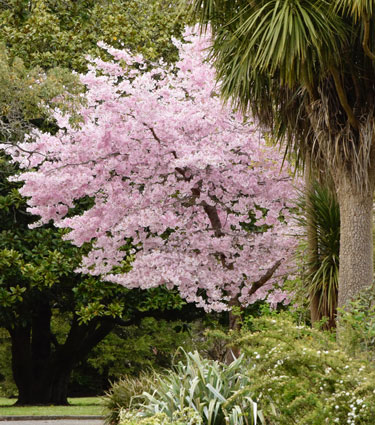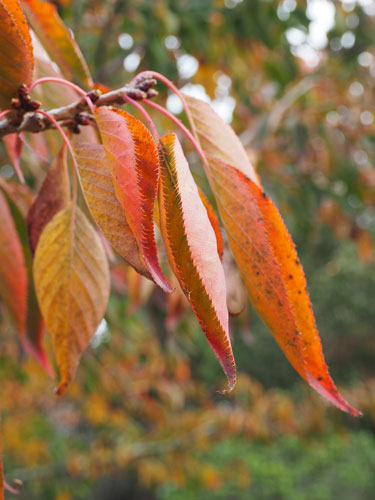Beauty and abundance
All the different species and varieties of flowering cherry, plum, cherry, peach, nectarine, apricot and almond trees all belong to the Prunus genus. Some have been bred to give an abundance of beautiful fruit to eat. Others are grown mainly for their extended, more spectacular display of spring blossom.
Cherry blossom
There are so many stunning flowering cherry blossom trees, that it can be hard to decide which one to plant. The main things to consider are the ultimate size and shape of the tree and its flowering time. If you have the space, planting two or more different varieties with different flowering times makes for longer lasting delight with a blossom show that stretches throughout spring. On the other hand, for an avenue planting, choosing just one variety gives the most spectacular show, albeit only for a few weeks.
One of the favourite avenue trees and earliest to bloom, around the first week of September, is the white Yoshino Cherry (Prunus x yedoensis) and its famous New Zealand bred sister, Prunus x yedoensis ‘Awanui’. In mid to late September ‘Awanui’ is a cloud of soft pink blossom. The large shell pink single flowers turn white as they progress through each spring. Year by year, the tree develops a beautiful horizontal weeping form as it matures.
Another favourite for driveways and street planting, Prunus ‘Accolade’ fills its wide spreading branches with large clusters of rich pink double flowers. ‘Accolade’ one of the best flowering cherry varieties for autumn foliage colour.
Prunus serrulata ‘Shirotae’ is the Mount Fuji cherry, another wide-spreading tree with beautiful horizontal form and branches that weep with age. In mid spring it is clothed in snow-white flower clusters amid soft green young leaves. A favourite pink form of this Japanese beauty is Prunus serrulata 'Shimidzu Sakura’ . It erupts in mid spring with pendant clusters of frilly double flowers that open white from pink buds. ‘Shimidzu Sakura’ is a modest sized tree with a graceful spreading habit that suits a smaller garden and has excellent autumn colour.
Weeping cherries, Prunus subirtella ‘Falling Snow' and ‘Pendula Rosea’ are popular for small gardens, with layer upon layer of cascading branches. Prunus serrula produces dainty white flowers but is mostly treasured for its beautiful metallic, mahogany-red bark with horizontal marking.
What not to plant
Tempting though it is, some blossom trees should not be planted. Deep cerise pink Taiwan cherry trees (Prunus campanulata) provides striking mid winter colour and tui adore them. But unfortunately this species (and its similar cultivars) is fast becoming one of our worst environmental weeds, particularly in warm northern regions. It crowds out native tree species that provide food for native birds all year round.
The sterile cultivar, Prunus campulata ‘Pink Cloud’, is a softer shade of pink, and still a beautiful tree that puts on a stunning mass display in early spring. It is loved by the nectar feeders and is safe to plant.
Flowering cherry trees care and cultivation
- Choose a sunny sheltered location. Full sun is best for blossom trees as shaded branches produce less blossom than those in sun. But avoid windy sites; strong wind can strip the blossom from a tree and ruin its shape.
- Choose a variety to suit your location. Ideally, there will be enough space so that the tree ’s natural shape can reach its full potential without the need to prune for size control.
- Plant in good soil. The key to success with any tree is a thriving root system. Give them a good start in well-drained soil, enriched with compost and controlled release fertiliser. Trim roots that have become root bound and circling around the container.
- Stake young trees to keep them straight and aid root developement and. Install stakes before planting to avoid damaging the roots. Ideally use 2 or 3 stakes about 20cm away from the trunk, and secure with soft fabric ties.
- Water young trees during dry spells. Mulch to keep moisture in, especially in the first year after planting and on hot or windy sites.
- If suckers grow from the base of the tree, remove them before they ruin the shape of the tree.
Little fruit trees
Modern dwarf varieties of stone fruit offer the works for small gardens - fruit and blossom on a baby tree that is suitable for growing in a tub. Dwarf fruit trees require minimal pruning if any. Some also have the advantage of reduced winter chill requirements which means they will fruit well in milder North Island climates.
Dwarf Cherry 'Griotella'™ is stunning with white blossom in spring, then tart bright red fruit that are perfect for tarts and preserves.
Dwarf apricot ‘Aprigold’ bears full size, flavoursome fruit early in the season and is well suited to the warmer areas of New Zealand.
Dwarf peach ‘Honey Babe’ and dwarf nectarine ‘Nectar Babe’ make a good garden pair, one pollinating the other for more prolific fruiting. Both have showy pink blossom in spring. Fruits best near other peaches or nectarines for cross pollination.
Dwarf peach ‘Rose Chiffon’ produces beautiful double rose red blossom in spring followed in late summer with juicy, white fleshed fruit. This one is best grown in northern areas of the country to ensure the fruit ripens sufficiently. Dwarf Nectarine ‘Garden Delight’ also has a low chilling requirement and showy pink blossom.
Pruning
Winter is pruning time for deciduous fruit trees. In the first few years of a tree’s life pruning is done to encourage a nicely shaped tree with a strong framework of fruiting branches.
On older established trees, pruning is all about getting sunlight into the tree. More light means more fruit! Pruning is also about rejuvenation - stimulating the growth of younger, more productive fruiting branches.
Dwarf fruit trees need little pruning, simply a light trim at the end of summer to remove any dead or over-crowded branches. Trees not grown for fruit production don’t need pruning unless it is to remove damaged branches or shape the tree. Pruning of ornamentals should be done after flowering in late spring, as winter pruning means cutting off the flower buds. More importantly, there is a greater risk of silver leaf disease when trees are pruned in winter.
Prune stone fruit when the weather is dry, ideally in late summer and autumn after harvest. If pruning in winter, always prune on a dry sunny day with preferably a few more dry days to come. This reduces the risk of diseases penetrating the pruning cuts. Seal any pruning cuts larger than 2cm with a pruning paste and spray with copper and spraying oil. This will protect the smaller cuts and reduce overwintering pests and diseases.
The art of successful pruning is knowing what basic shape you want and which wood they produce fruit on. Plums, cherries, and apricots fruit on spurs for several years. New spurs form as old ones die. Pruning mainly involves removing most new growth, plus old dead or diseased wood, to control size and maintain an open shape for light and air movement, and easy picking.
Peaches and nectarines fruit on one-year-old wood; the wood that grew last year will carry fruit this year. Shortening this one-year wood to half its length encourages new growth while enabling size to be maintained.
Espaliering is an ideal method of training and pruning when space is limited. This involves creating a framework of branches over a flat vertical space.
TIP: Keep pruning tools clean and sharp, both to make the job easier and minimise disease. For extra care, wipe the blades with methylated spirits between plants to reduce spread of infection from one tree to the next.

4-Jun-2024

Prunus 'Awanui'

The Sakura Garden in Featherston

Prunus 'Pink Cloud'

Peach

Dwarf peach

Autumn colour

